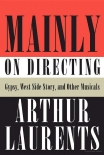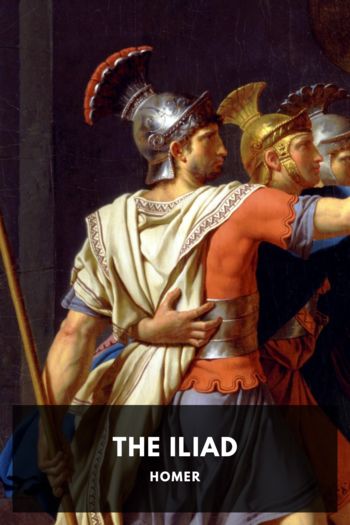Mainly on Directing, Arthur Laurents [best books for students to read TXT] 📗

- Author: Arthur Laurents
Book online «Mainly on Directing, Arthur Laurents [best books for students to read TXT] 📗». Author Arthur Laurents
I didn't want to direct: drag turned me off. In life, I was introduced to it at my first meeting of the Gay Activists Alliance at the old Firehouse in the Village. Tom Hatcher had joined the Alliance much earlier and brought me into the fold. When I walked through the Firehouse door, I felt I was politically home again. The battered jeans, the scraggly beards, the “Point of order! Point of order!”—all the appurtenances of the left-wing past I had been missing were there. The desired effect of the Hollywood Witch Hunt had been silence. Now that silence was broken, and by more than the usual voices overshouting each other. This was a kind of screeching from fiery protesters with wild mops of hair in embroidered tunics worn over battered jeans and muddy work boots: drag queens of the gay revolution—aka transvestites ranting against “straight” gays who, they claimed, were ashamed of them and trying to push them out of the Gay Liberation picture. They were right; they still are.
Drag in the theatre wasn't to my taste, either. I didn't and don't consider all-male productions like Clifford Williams's As You Like It at the Old Vic in London in the sixties as drag. Brilliant acting added a new dimension to the play: was Orlando in love with Rosalind as a woman or as a man pretending to be a woman? Real drag I first saw in the theatre—a facsimile of theatre, really—much earlier, in Greenwich Village, where abbreviated versions of hit Broadway musicals were performed with switched-gender casts. A Pal Joey featured the most elegantly witty Vera I've ever seen. Played by a man dressed as a woman, Lynne Carter was technically a drag queen, but too good an actor to be slotted in any category. Still, drag it was.
The unforgettable Charles Ludlam, who had his own theatre on Sheridan Square, was also an actor and also a drag queen. His drag in Camille was ridiculous, as was everything he wore and did, most spectacularly his classic Mystery of Irma Vep with Everett Quinton. I never saw as much of Ludlam and his Ridiculous Theatrical Company as perhaps I should have; the drag on stage inevitably became tiresome to me because of the exaggerated costumes and the camp humor that came with it mercilessly. A limitation on my part? I also think certain Samuel Beckett plays are the Emperor's New Clothes.
I don't dismiss out of hand. I always went, I always saw. Years ago, when the theatre was awash in New Theatre, I got Richard Poirier to go with me to a Richard Foreman Ontological-Hysteric Theatre play. As customary, the stage was sectioned with lines of string, and light bulbs wavered at random. When the play was over, the author of The Performing Self was succinct: “A crock,” he said. Does that validate my opinion? Does the wholesale acclaim of the upper intellectual strata validate every stage direction by Beckett? Time validates, but how much, and for how long? The avant garde does influence now and then, but everything changes except the avant garde. Eventually, praise be, theatre returns to character and story. Ideas come naturally and so, happily, can passion, scorned though it is at the antiseptic moment.
I'm still open to the new; I go, though not as often as before. I want to leave a theatre glad I came; now it's an effort not to leave at the intermission. Nor am I alone. There is a distinct trend to intermissionless works. Once in a while there's water in the Sahara: Spring Awakening. I admired and enjoyed it. The reviewers went overboard. The work would forever alter musical theatre, they announced. So did the authors. It won't. Does that matter? If the creators of the show believe it, yes; if the readers believe it, yes, because the next time they read it, they will cry wolf. What I think will have a lasting influence in Spring Awakening is the musical staging. It's truly an innovation in staging musical numbers. There have been changes in doing such: the snaking microphones across faces, including those of lovers trying to kiss, in Rent; the handheld phallic microphones the boys whip out in Spring Awakening as though they were whipping out their penises, which is what they are meant to look like—but not in Jersey Boys, where a handheld microphone is a handheld microphone. All the flaunted microphones have been influences that I doubt will last—they're too limiting. There's also John Doyle's use of instruments: very effective in a humorous Sweeney Todd, annoying in a manufactured Company (which was in desperate need of a choreographer), a gimmick if used again. The musical staging in Spring Awakening, however, is direct from the characters, the story, the milieu, the passions, and thus points where to go and what to do when you get there: think, imagine, create.
I agreed to direct Cage because I thought the production would never happen. Allan Carr had come a cropper trying to produce it, his first Broadway adventure, with a Vegas touch. The Cage aux Folles set on the French Riviera in the movie was to become The Queen of Basin Street, set in New Orleans, for the musical, with direction by Mike Nichols, choreography by Tommy Tune, score by Maury Yeston, and book by Jay Presson Allen (who began with the stage direction “The décor is early faggot,” and that's as far as I read). The combined royalties of these boldface names guaranteed financial failure for producer and investors, as Fritz Holt and Barry Brown





Comments (0)